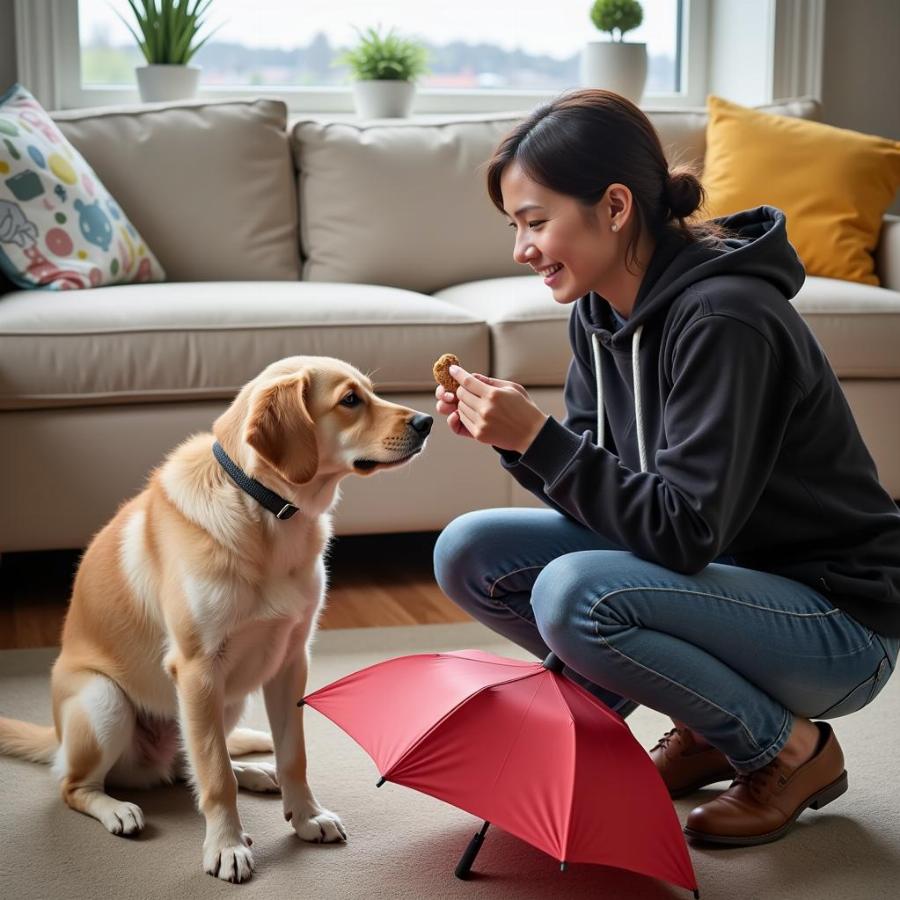Protecting our furry friends from the elements is a top priority for any dog owner. When it comes to rain, “umbrellas for dogs” often pop up as a potential solution. But are these miniature canopies a practical necessity or just a fleeting novelty? This article delves into the world of dog umbrellas, exploring their pros, cons, and everything in between to help you decide if this accessory is right for your canine companion.
Do Dogs Really Need Umbrellas?
While the image of a pup strolling under a tiny umbrella might evoke a chuckle, the practicality of dog umbrellas is often debated. For some breeds, especially small, short-haired dogs, an umbrella can offer welcome protection from rain, sleet, and even intense sun. It can keep them dry and comfortable, preventing chills and reducing the need for a lengthy post-walk drying session. However, for larger dogs or those with thicker coats, an umbrella might be more of a hindrance than a help.
Consider your dog’s individual needs. Does your dog detest rain? Does he shiver easily when wet? Is he prone to skin issues that could be aggravated by dampness? If so, a dog umbrella might be a worthwhile investment.
Choosing the Right Umbrella for Your Dog
Not all dog umbrellas are created equal. There are various styles available, each with its own set of advantages and disadvantages. Some umbrellas attach directly to a dog’s leash or harness, providing hands-free operation. Others are handheld, offering more control and flexibility.
When choosing an umbrella, consider size, durability, and ease of use. Opt for a lightweight, sturdy umbrella that is appropriately sized for your dog. Transparent umbrellas can help reduce your dog’s anxiety by allowing them to see their surroundings.
Getting Your Dog Used to an Umbrella
Introducing a new accessory can be challenging, especially for dogs wary of unfamiliar objects. Start by letting your dog sniff and investigate the umbrella. Reward them with treats and praise for positive interactions. Gradually introduce the open umbrella, associating it with positive experiences. Short, supervised sessions are key to building positive associations.
 Training a Dog to Use an Umbrella
Training a Dog to Use an Umbrella
Patience and positive reinforcement are crucial. Never force your dog to use the umbrella. If they show signs of stress or discomfort, take a break and try again later.
Alternatives to Dog Umbrellas
If your dog refuses to cooperate with an umbrella, don’t despair! There are other ways to keep them dry and comfortable in inclement weather. Dog raincoats and waterproof booties are excellent alternatives, offering full-body protection. For short walks in light rain, a quick towel dry might suffice.
Conclusion: Umbrellas for Dogs – A Case-by-Case Basis
Ultimately, the decision of whether or not to use an umbrella for your dog depends on your individual dog’s needs and preferences. While they can be beneficial for some, they might be unnecessary or even counterproductive for others. Carefully consider your dog’s personality, breed, and tolerance for new experiences before making a purchase. By doing so, you can ensure that your furry friend stays happy, healthy, and dry, come rain or shine.
FAQ:
- Are dog umbrellas safe? Yes, when used correctly. Ensure the umbrella is securely attached and doesn’t obstruct your dog’s vision.
- What size umbrella do I need for my dog? Measure your dog’s height and width to determine the appropriate umbrella size.
- How do I get my dog used to an umbrella? Use positive reinforcement and gradual introduction.
- Are there alternatives to dog umbrellas? Yes, dog raincoats and booties are excellent alternatives.
- Where can I buy a dog umbrella? Pet stores and online retailers carry a variety of dog umbrellas.
- Are dog umbrellas necessary? Not always. Consider your dog’s individual needs and preferences.
- Can I use a regular umbrella for my dog? It’s not recommended. Dog umbrellas are specifically designed for canine use.